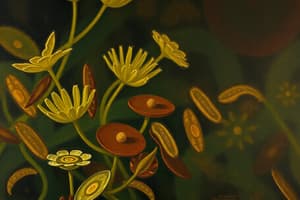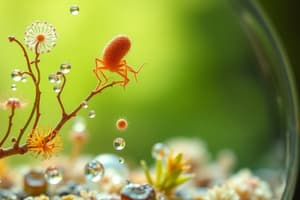Podcast
Questions and Answers
What marks the beginning of a girl's reproductive capability?
What marks the beginning of a girl's reproductive capability?
- The start of puberty
- Oogenesis
- Fertilization
- Menstruation (correct)
Which hormone is primarily responsible for the changes during puberty?
Which hormone is primarily responsible for the changes during puberty?
- Hormones (correct)
- Testosterone
- Estrogen
- Insulin
Which organ is responsible for producing sperm in males?
Which organ is responsible for producing sperm in males?
- Penis
- Ovaries
- Uterus
- Testes (correct)
What structure carries sperm to the penis in the male reproductive system?
What structure carries sperm to the penis in the male reproductive system?
At what age does puberty typically start for boys?
At what age does puberty typically start for boys?
Which of the following is a change that occurs in girls during puberty?
Which of the following is a change that occurs in girls during puberty?
Where does fertilization take place in the female reproductive system?
Where does fertilization take place in the female reproductive system?
Which type of microorganism is considered non-living?
Which type of microorganism is considered non-living?
What is the primary gas that we breathe out during respiration?
What is the primary gas that we breathe out during respiration?
Which of the following best describes a vector in the context of disease transmission?
Which of the following best describes a vector in the context of disease transmission?
Which organ is NOT included in the respiratory system?
Which organ is NOT included in the respiratory system?
What role do hormones play during puberty?
What role do hormones play during puberty?
What is the function of the diaphragm in the respiratory system?
What is the function of the diaphragm in the respiratory system?
Which of the following is NOT a common respiratory disorder?
Which of the following is NOT a common respiratory disorder?
Which term refers to tiny living organisms that cannot be seen with the naked eye?
Which term refers to tiny living organisms that cannot be seen with the naked eye?
What does menstruation involve?
What does menstruation involve?
Flashcards are hidden until you start studying
Study Notes
Words to Learn
- Oxygen: Colorless gas, part of the air we breathe.
- Carbon dioxide: Colorless gas, breathed out during respiration, used by plants.
- Host: Living organism a parasite infects.
- Bacteria: Tiny organisms that can cause disease.
- Parasite: Tiny organism that infects a host.
- Fungi: Living organisms that obtain energy from the environment.
- Infection: To cause something to pass from one place to another.
- Transmit: To spread a disease.
- Vector: Organism (like an insect) that spreads a disease.
- Physical barrier: Prevents germs from entering the body (e.g., skin).
- Chemical barrier: Destroys germs on body surfaces (e.g., mucus).
- Mucus: Slimy substance in the body.
- Microorganisms/Microbes: Tiny living organisms not visible to the naked eye.
- Fertilization: Joining of male and female sex cells.
- Hormones: Chemicals in the body that cause changes.
- Menstruation: Release of an unfertilized egg and uterine lining.
- Ova: Female sex cells.
- Puberty: Age when a person can reproduce.
- Reproductive system: Body parts involved in reproduction.
- Sperm: Male sex cells.
Respiratory System
- Function: Allows breathing in oxygen and out carbon dioxide.
- Organs: Nose, trachea, lungs, diaphragm.
- Breathing process: Inhalation (breathing in) and exhalation (breathing out).
- Diaphragm: Muscle that assists in breathing.
- Respiratory Disorders: Examples - asthma, bronchitis, pneumonia.
- Maintaining health: Avoid smoking, good air quality, exercise, and hygiene.
Reproductive System
- Changes During Puberty: Boys and girls experience changes, enabling reproduction.
- Reproductive System's Role: Produce cells needed for reproduction.
- Boys: Produce sperm (male sex cells).
- Girls: Develop eggs/ova (female sex cells).
- Fertilization: Sperm and egg join to create a new living being.
Puberty
- What is Puberty? The stage in life when the body changes enabling reproduction.
- Why Does Puberty Happen? Caused by hormones.
- Growth Spurt: Rapid growth during puberty, with variations for boys and girls.
- Changes in Hair: Hair growth in various areas (e.g., face, armpits).
- Skin Changes: Oily skin, pimples.
- Changes in Boys: Broader shoulders, chest, muscle development, deeper voice.
- Changes in Girls: Wider hips, breast development, deeper (less pronounced) voice
Male Reproductive System
- Includes: Testes (produce sperm), sperm duct, and penis.
Female Reproductive System
- Includes: Ovaries (produce ova), uterus, oviducts (where fertilization occurs), and birth canal.
Microorganisms
- Bacteria: Single-celled organisms in various environments. Some are beneficial; others cause disease.
- Viruses: Not considered living, replicate by infecting host cells.
- Fungi: Multicellular organisms involved in decomposition.
- Parasites: Live on or inside other organisms.
Infectious Diseases
- Illnesses caused by tiny germs (bacteria, viruses, or parasites).
- Spread by air, water, touch, or insects.
- Symptoms include: fever, cough, tiredness, stomach issues.
- Mucus traps germs.
Body Defenses
- Skin: Barrier to prevent germs from entering the body.
- Acid in Stomach: Kills germs in food.
Studying That Suits You
Use AI to generate personalized quizzes and flashcards to suit your learning preferences.




